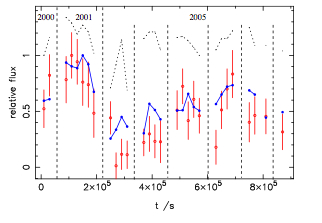|
Title Professor Education Ph.D. Physics – University of Leciester (UK), 1988 Previous Experience Dr. Turner worked previously for the Universities Space Research Association as an associate research scientist on base at NASA’s Goddard Space Flight Center (Greenbelt, MD). There she worked on several projects, including supporting guest observers for the ROSAT mission, and scientific time-line planning for the BBXRT instrument flown on shuttle mission STS 35.
Dr. Turner retired from the Physics Department in December 2019.
Professional Interests The AGN team work on the study of active galactic nuclei (AGN). While all galaxies are now thought to harbor million-billion solar mass black holes at their center, only a small fraction of these are actively accreting gas; this accretion process results in the release of a large amount of energy very close to the nuclear black hole leading to these being known as ‘active’ galactic nuclei. X-rays are produced very close to the black hole and thus studying AGN in the X-ray bandpass allows us a unique probe of accreting systems and of material in the strong gravity regime. Our work at UMBC is focused on studying the X-ray spectra of AGN. The observed spectra are the sum of an X-ray continuum and reprocessed X-ray emission. The X-ray continuum likely arises from ultraviolet photons produced in the accretion disk that upscatter to X-ray energies in a plasma of relativistic electrons. Some of this X-ray continuum radiation shines back on to the accretion disk surface and ‘reflects’ from that, and all of the radiation travels through clouds of gas that shroud the nucleus before reaching the observer. These interactions of X-rays and material in the nucleus produce an imprint on the X-ray spectrum of many emission and absorption features that allow diagnostics to be made of these accreting systems. Our work currently concentrates on analysis and interpretation of data from the Chandra, XMM-Newton and Suzaku satellites although it also naturally includes consideration of the sources behavior across a wide bandpass of energy. Selected Publications The Hard X-Ray Spectrum of NGC 1365: Scattered Light, Not Black Hole Spin, L. Miller & T.J.Turner, 2013, Ap J 773, 5 X-Ray Characteristics of NGC 3516: A View through the Complex Absorber, T.J.Turner, L. Miller, S.B. Kramer, J.N.Reeves, 2011, Ap J 733, 48 Significant X-ray Line Emission in the 5-6 keV Band of NGC 4051, 2010 T.J.Turner, L. Miller, J.N.Reeves, A. Lobban, V. Braito, S.B. Kraemer, D.M. Crenshaw, Ap J 712, 209 Cosmic-ray Spallation in Radio-quiet Active Galactic Nuclei: A Case Study of NGC 4051, 2010, T.J.Turner & L. Miller, Ap J 709, 1230 Suzaku Observation of a Hard Excess in 1H 0419 – 577: Detection of a Compton-Thick Partial-Covering Absorber, 2009, T.J.Turner, S.B. Kraemer, J.N. Reeves, K.A. Pounds, Ap J 698, 99 Tracing a disk wind in NGC 3516, T.J.Turner, J.N. Reeves, S.B.Kramer, L. Miller, 2008, A&A, 483, 437 Fourier-resolved energy spectra of the Narrow-Line Seyfert 1 Mkn 766, P. Arévalo, I.M. McHardy, A. Markowitz, I.E. Papadakis, T.J. Turner, L Miller, J. N. Reeves, 2008, MNRAS, 387, 279 An absorption origin for the X-ray spectral variability of MCG-6-30-15, L. Miller, T.J.Turner, J.N. Reeves, 2008, A&A 483, 437 |
|

